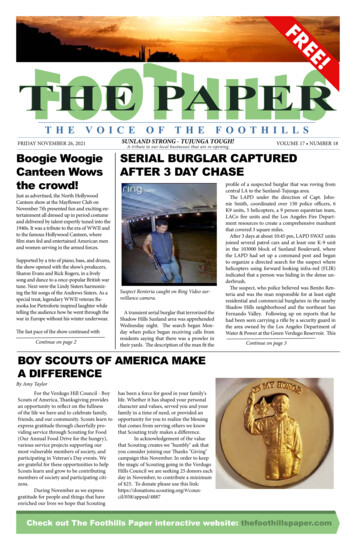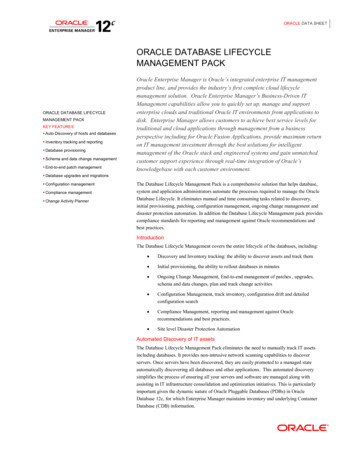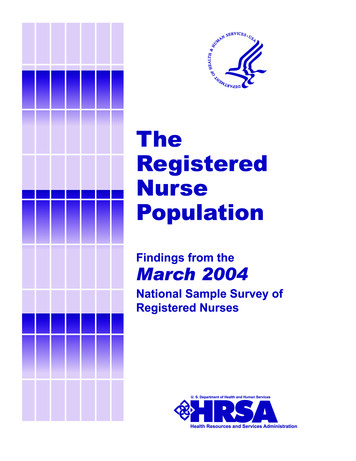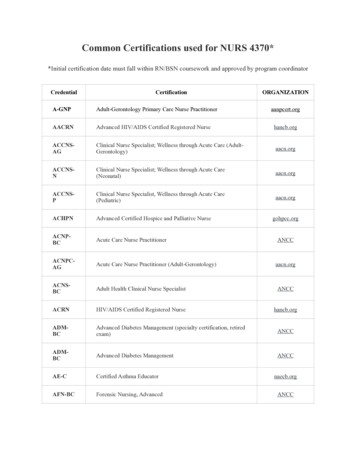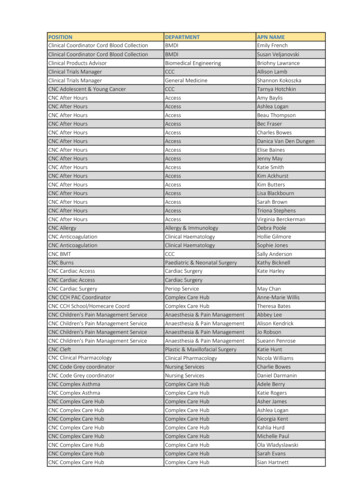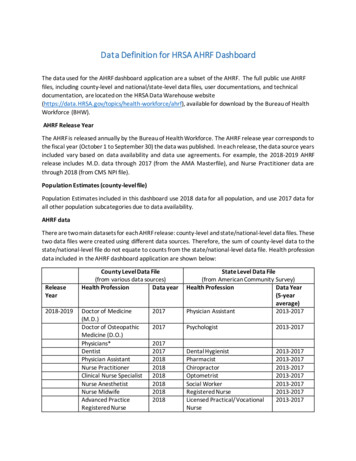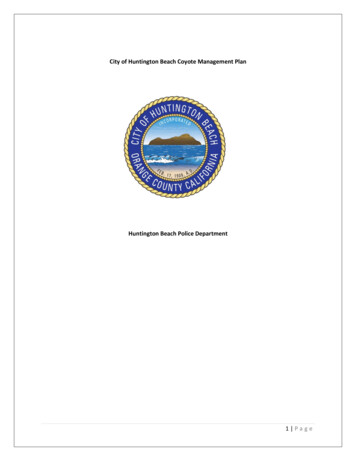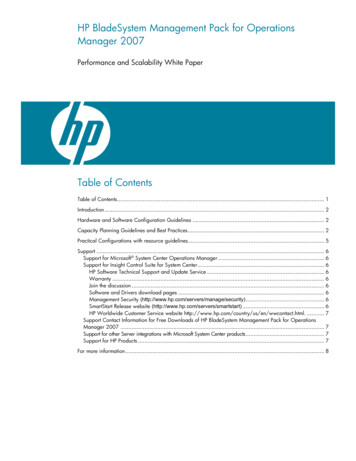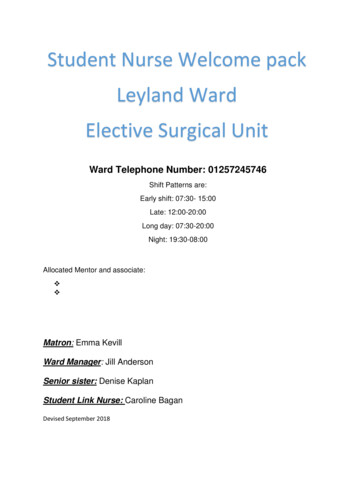
Transcription
Student Nurse Welcome packLeyland WardElective Surgical UnitWard Telephone Number: 01257245746Shift Patterns are:Early shift: 07:30- 15:00Late: 12:00-20:00Long day: 07:30-20:00Night: 19:30-08:00Allocated Mentor and associate: Matron: Emma KevillWard Manager: Jill AndersonSenior sister: Denise KaplanStudent Link Nurse: Caroline BaganDevised September 2018
Welcome to the Orthopaedic Unit at Chorley and South Ribble District GeneralHospital. Leyland Ward is a mixed sex ward and consists of twenty five inpatientbeds.Below are just some of the elective procedures on Leyland ward and can be done asday case or inpatient. Total Hip Replacement Total Knee Replacement Hip/Knee/Ankle Arthroscopies Spinal Decompressions / Discectomy/ fusions Foot Surgery Shoulder Surgery ACL reconstructionsDuring your Placement with us we hope to increase your knowledge and skills in thecare of patients with orthopaedic problems. Our aim is to assist you to develop yourconfidence in all areas, time management, interpersonal communication, andprioritisation.Leyland ward embraces the initiative Collaborative Learning in Practice (CLiP) whichenhances both the quality of the learning environment and increases the placementcapacity for students.It is coaching not Mentoring .The traditional method of mentoring students is widely known to have its problemsbecause of service demands. Some Mentors can find it difficult to balance theirworkload equally to enable time to teach learners, which can be stressful for bothstudent and Mentor. A small percentage of students who leave the programme isattributed to their perceived lack of support.The CLiP process entails allocating between 14 & 22 students to a practiceenvironment, utilising the coaching method as opposed to the traditional 1:1mentoring technique. The learners are then divided into smaller groups of 1 - 3students, from all year groups, who are supervised by a coach, to deliver holisticcare to their patients. This includes essential skills, documentation, ward rounds and
hand-overs to the next shift. In this environment, the students may also have theopportunity to follow their patient’s journey, by visiting specialist bays, going totheatre with their patients and partaking in specialised treatments, thus increasingtheir knowledge and experience.An overarching Mentor oversees the coach, providing support, and maintainsresponsibly for the student’s practice assessment documentation.WHAT YOU CAN EXPECT FROM US You will receive an induction into your work area to ensure you are familiarwith the environment and are able to practice safely. You will discuss your learning needs and outcomes at the beginning of thePlacement. We will provide an environment conducive to meet identified individual studentlearning needs, which is also safe and healthy. During your placement you will be allocated a mentor and an associatementor to work alongside. The mentor will be a qualified practitioner who will assist and support youduring your clinical work. Your mentor will assess your performance against your course learningoutcomes, and provide feedback to help you develop your skills. You will receive supervision during your clinical practice. You will be a valued member of the multidisciplinary team during yourplacement, and can expect support from all our colleagues We will listen to your feedback about your placement and will respond to anyissues raised confidentially and sensitivelyWHAT WE EXPECT FROM YOU We expect you to arrive on time for planned shifts and any other activityidentified by the Mentor or delegated supervisor. We expect you to ensure your Mentor is aware of your learning outcomes forthe placement and specific learning needs. We expect you to act in a professional manner. We expect you to dress in accordance with your College / University uniformpolicy, and also in accordance with the Trust dress code. You should inform your mentor or delegated person if you are unwell and not
able to attend your placement. The process for how to do this will be covered on your induction to the ward/initial interview. We expect you to maintain and respect confidentiality at all times. This appliesto clients, their records and discussions between the student and the Mentor. We would like you to raise any issues regarding your placement with yourMentor or the Ward Manager if this is not possible you should contact yourlink tutor/placement co-ordinator. Your mentor will be responsible for your assessment, co-ordination of learningand personal support. However students are responsible to identify their ownlearning needs and seek opportunity for this if one arises.On the ward you will have supernumerary status throughout your placement. You willbe assigned a Mentor and an Associate Mentor, their job is to act as a guide to theward and provide support and knowledge to you. You will not be working directly withthem every shift, but we ensure you will work with your Mentor at least 40% of yourallocation. It will be your responsibility to ensure you book your initial, interim andfinal interview dates with your Mentor. During this allocation you will be expected towork Early, Late and night shifts plus weekends. Your Rota will be allocated to you, ifyou have any requests you will need to speak to your mentor or the nurse whocompletes the rota. Please ensure that you do this in advance.Please leave your contact details with the ward at the beginning of your placement. Ifyou need to call in sick for a shift please call the ward to inform them. You also needto tell them when you think you will be returning to work. Please inform the ward atthe earliest opportunity. Once you return to work you need to discuss with yourmentor a plan to make up the missed hours.Remember that if you have worries or queries then please raise them soonerrather than later we are here to support you.At Lancashire Teaching Hospitals our values set out the behaviours we expect ourstaff to show to one another when caring for our patients. Our values are at the verycentre of what we all do and define who we are both as individuals and as anorganisation. Our values are more than just words; they are the bedrock of ourorganisation and should remain constant in every situation. We seek to live by our
values so we can create a positive, trusting, supportive atmosphere enabling us toalways deliver an exceptional quality of care. We have high standards for our staff,we believe that we should always act with professionalism, integrity, compassion,empathy, understanding, showing dignity and respect to staff, patients and familiesfrom all groups or backgrounds.The five core values we live by are; Caring and Compassionate – We treat everyone with dignity and respectdoing everything we can to show we care Recognising Individuality – We respect value and respond to every person’sIndividual needs Seeking to Involve – We will always involve you in making decisions aboutyour care and treatment and are always open and honest Team working – We work together as one team and involve patients Taking personal responsibility – We each take responsibility to give thehighest standards of care and deliver a service we can always be proud ofPlacement CharterThis Charter demonstrates the Placement’s commitment to provide asafe and high quality learning environment for all learners to preparethem for their future roles working collaboratively in multi-professionalteams. The ‘Placement Pledges’ and the ‘Rights, Roles andResponsibilities of learners’ instil the values embedded within the NHSConstitution (DH 2013) and Health Education England’s NHS Education OutcomesFramework (DH 2012).Placement PledgesRights, Roles and Responsibilities oflearnersEnsure all learners are welcomed,valued and provided with aninclusive, safe, stimulating andsupportive learning experience.Prepare adequately for the placement, includingcontact with the placement in advance. Discloseany health or learning needs that may impact onthe placement, or the achievement of learningoutcomes.Promote a healthy and ‘just’workplace culture built on opennessand accountability, encouraging alllearners to raise any concerns theymay have about poor practice or‘risk’, including unacceptableRaise any serious concerns about poor practiceor ‘risk’, including unacceptable behaviours andattitudes observed at the earliest opportunity. Beclear who to report any concerns to in order toensure that high quality, safe care to patients/service users and carers is delivered by all
behaviours and attitudes theyobserve at the earliest reasonableopportunity. Respond appropriatelywhen concerns are raised.staff.Provide all learners with a namedand appropriately qualified / suitablyprepared mentor / placementeducator to supervise support andassess all learners during theirplacement experience.Actively engage as an independent learner,discuss learning outcomes with an identifiednamed mentor / placement educator, andmaximise all available learning opportunities.Provide role modelling andleadership in learning and working,including the demonstration of coreNHS ‘values and behaviours’ of careand compassion, equality, respectand dignity, promoting and fosteringthose values in others.Observe effective leadership behaviour ofhealthcare workers, and learn the required NHS‘values and behaviours’ of care andcompassion, equality, respect and dignity,promoting and fostering those values in others.Facilitate a learner’s development,including respect for diversity ofculture and values aroundcollaborative planning, prioritisationand delivery of care, with the learneras an integral part of the multidisciplinary team.Be proactive and willing to learn with, from andabout other professions, other learners and withservice users and carers in the placement.Demonstrate respect for diversity of culture andvalues, learning and working as part of themulti-disciplinary team.Facilitate breadth of experience andinter-professional learning inplacements, structured with thepatient, service user and carer at thecentre of care delivery, e.g. patientcare pathways and commissioningframeworks.Maximise the opportunity to experience thedelivery of care in a variety of practice settings,and seek opportunities to learn with and frompatients, service users and carers.Adopt a flexible approach, utilisinggeneric models of learner support,information, guidance, feedback andassessment across the placementcircuit in order to support theachievement of placement learningoutcomes for all learners.Ensure effective use of available support,information and guidance, reflect on all learningexperiences, including feedback given, and beopen and willing to change and develop on apersonal and professional level.Offer a learning infrastructure andresources to meet the needs of alllearners, ensuring that all staff whosupervise learners undertake theirresponsibilities with the due care anddiligence expected by theirComply with placement policies, guidelines andprocedures, and uphold the standards ofconduct, performance and ethics expected byrespective professional and regulatory bodiesand organisations.
respective professional andregulatory body and organisationRespond to feedback from alllearners on the quality of theplacement experience to makeimprovements for all learners.Evaluate the placement to inform realisticimprovements, ensuring that informal and formalfeedback is provided in an open andconstructive manner. ‘Learner’ refers to all health, education and social care students, trainees, hostedlearners. ‘Placement’ relates to all learning environments / work based learning experiences. ‘Mentor’/ ‘placement educator’ relates to all trainers / supervisors / coordinatorsappropriately qualified / suitably prepared to support learners. ‘Professional and regulatory body and organisation’ relates to standards required toensure patientand public safety, and professional behaviours.Leyland ward Team:Leyland ward has a large multidisciplinary orthopaedic team consisting oforthopaedic consultants and their medical team, nurses, Assistant PractitionersHealthcare Assistant’s physiotherapists, occupational therapists, pharmacists,discharge co-ordinators, Hospital at home team, ward clerks Housekeepers andvoluntary help. We also liaise with many outside services to such as social services,District Nurses and GP’s. The key to the successful working within our team iscommunication, and are integral in helping to coordinate safe and effectiveadmissions to discharge packages.ConsultantsLower limb Miss Cross Mr McLauchlan Mr Kumar Mr Helm Mr Boden Mr Hassan Mr Raut Mr Mittal Mr A McEvoyUpper LimbSpinal Mr Khatri Mrs Vadvah Mr Woodruff Mr Bourne Mr Redfern Mr Austin Mr Hughes Mr Baker
The term ‘orthopaedics’ is derived from the Greek ortho (‘correct’, ‘straight’)and pais (child).It was first used in 1741, when it most frequently applied to the care of crippledchildren, often with spine and limb deformities. Orthopaedics today involves the careof the musculoskeletal system of the human body.The musculoskeletal system is responsible for every movement an individual makes,from raising an arm to more complex tasks like running, jumping, surfing or dancing.It involves bones, joints, tendons, ligaments, muscles and nerves. When somethinggoes wrong with the musculoskeletal system, an individual’s range of motion orability to move can be impacted.An orthopaedic surgeon is a medical doctor with extensive training in the diagnosisand surgical, as well as non-surgical, treatment of the musculoskeletal system.Some of the common problems orthopaedic surgeons treat include: Musculoskeletal trauma Sports injuries Degenerative diseases Infections Tumours Congenital disordersWhile some orthopaedists practice general orthopaedics, many specialise in treatingthe foot and ankle, hand, shoulder and elbow, spine, hip or knee.Others focus on a particular age group or area of orthopaedics, such as paediatrics,trauma, sports medicine, oncology, or the treatment of specific conditions such asosteoporosis, arthritis or work-related injuries.Learning opportunitiesCompetence and clinical skills will be gained when caring for patients allocated toyou on a daily basis. Students are encouraged to develop organisationalmanagement skills, guided by your coach/mentor. The allocation will depend onpatient needs and available skill mix of nurses on each shift. All staff work within theirteams as members of a larger team to facilitate quality nursing care for which is themain focus.
Year one Learning Journey IdeasAim to have 1-2 patients allocated to you at the commencement of each shift(considering learning needs for the patient you choose). Understanding the basics of Activities of daily Living Communication Spend the first week learning from the Healthcare assistants (longer ifrequired) Moving and handling Documentation and rounding charts Vital signs recordingYear Two Learning Journey ideasEach shift, have a consistent caseload of 2-4 patients, support and be involved in thelearning and development of year one students,Consider the differences between trauma & elective admissions: Complete admissions considering all aspects of Harm Free Care, risk assessments,care planning: consider all aspects of the nursing process Gain an understanding of Harm Free Care & look at Root Cause Analysis (RCA) &SBAR tool related to this: & how the outcome & learning is fed back to ward staff Learn how to complete a clinical incident online & why Read the SBAR file & ward information file Spoke placement in pre assessment clinic Complete a shift on day case. Complete theatre induction ASAP (if haven’t already done so)
Complete a day in orthopaedic theatre; reflect on in regards to A&P & future patientmanagement (care in recovery & handover needs to ward to ensure safety)Nutrition: Spoke with dietician/SALT (have goals) Ask ward link nurses about current practice/audits Learn how to access blood results via lab system online Focus on risk assessments & interventions utilised in practice to monitor/improvenutrition (nursing process) Consider areas in regards to nutrition for the following types of patients (both pre ns,olderpatients,gluten/lactose intolerant, culture issues/fasting Gain experience & confidence in handing over your patients in safety huddles &MDTs Learn how to use QMED Familiarise with the intranets policies on Deteriorating Patient & learn how to followpolicy: become familiar with using SBAR to communicate assessments/concerns torelevant MDTExposure to Mental Health/Vulnerable Adults: Spoke with dementia nurse (must have goals) Attend In House dementia friends session Spoke with discharge coordinator (Best Interests Meetings etc, DOLs) Access NICE guidelines re fractured hips and delirium.Challenging situations: Spoke with PALs. Spoke with matron (if appropriate and have goals) Look at friends and family feedback for ward (on exemplar board) and reflect on this. Read relevant policies and reflect on them. Learn how manager responds to clinical incidents and discuss duty of candour.
Sexual Boundaries: Read relevant policies including chaperoning. Reflect on one of your patients and how policies relate/could relate to them.Year Three Learning Journey ideasEach shift have a consistent caseload of a bay, overseeing second and firstyear students if appropriate ensuring you’re the running of the bay iscompleted.Medication Management: Be fully involved in all aspects, as appropriate, for your patients Spoke with ward pharmacist: learning outcomes to consider: NBM policy & medications Ordering, receiving, storing medications including controlled drugs, stockitems, patients regular medications, emergency drug cupboard items, PGDs,covert administration, self medicating policy, escalation policies/actions totake with medication errors/reactionsREMEMBER, that you will soon be qualified & the above will be yourresponsibility; take this opportunity to learn about the above & learn tocomplete the above in this learning period: IT IS EXTREMELY IMPORTANT.Your mentors & MDT can help you to do this; alongside your access to Trust &National Policies: it may be useful to make your own flow chart for how to dealwith each of the above & keep them in a file & immerse yourself in dealing withthe above (as appropriate) as much as possible in this student period Practice correct ANTT technique: practice educators could assist with this (inregards to medication prep) Attend a Length of Stay meeting with matron/manager & dischargecoordinator
Attend Bed Meetings with senior nurse if possible. Spoke with discharge coordinator (have goals) Observe a clinical incident form being completed online/participate incompleting this if appropriate Complete a Root Cause Analysis (RCA) with manager & learn how to presentthis as an SBAR Fully immerse self in delivering handovers, safety huddle, MDT (daily & full),take part in ward rounds, telephone, SBARs and post op care. Become familiar with using QMED and other referral systems: updating,discharge dates, printing, moving patients, finding patients Become familiar with utilising the BNF and Medussa Be fully involved in the discharge process especially in regards to medicationmanagement: become familiar with ascribe & processes used Become familiar with medical devices in regards to medicine administration: Consider care of substance misuse in patients: & policy/policies in regards tothis i.e. assessment/methadone prescription; & the needs of these individualsin regards to analgesia Consider spoke placement with the pain team (must have goals) Consider spoke with the alcohol nurse: consider aspects such asassessment/regimes, referrals, DOLsOther Spokes/Activities you should be able to do:Know the Ward/Trust aims: Access the Trust website & update self on aims Become aware of areas such as Harm Free Care/Safety Thermometer,CQUINs, Key Performance Indicators (KPI), Exemplar programme etc
Be aware of audits carried out in this area, by whom, when & why. We havepractice forms that you can carry out. Attend a Harm Free Care Panel with ward manager.Spokes: Physiotherapist:Post-operative patient assessments, chest physio, stair practice, bed transfers,outreach physio, daily MDT meeting. Occupational Therapist (OT):AMT assessment 3-4/7 post op, initial assessments, environmental visits, kitchenpractice, dressing practice, daily MDT meeting Weekly MDT (Multidisciplinary Team) Meeting: Discharge Coordinator:Continuing healthcare (CHC) process, Length of Stay (LOS) meetings & hospitaldelays, simple & complex discharges, liaising with district nurses (strong links withcommunity), discharge planning meetings, best interest meetings, bed manager roleat times, patient flow issues, trouble shooting discharges, work with social workersoften. Theatre Induction:From Year 1, mentors can arrange this for you (must be completed before can spokein theatre).Previous students strongly advise that you do this at the earliestopportunity as they only take place every so often. This covers theatre etiquette andmoving and handling. Ward Pharmacist:Attend a half day after you have completed the Safe Administration of MedicationsBooklet & become familiar with the basics of this process. Orthopaedic Outpatients & Fracture Clinic:
Can observe a variety of pre & post admission situations & a wide range of patientsincluding childrenWITH EACH OF THE ABOVE, IN ORDER TO ENSURE MEANINGFUL LEARNINGEXPERIENCES THAT LINK THEORY TO PRACTICE, IT IS IMPORTANT THATYOU UTILISE A REFLECTION TOOL IE KOLB, GIBBS ETC TO REFLECT ON &MAKE SENSE OF THE LEARNING THAT YOU HAVE GAINED FROM THESEEXPERIENCES & HOW THEY FIT INTO YOUR LEARNING JOURNEY & WHY &HOW YOU WILL PROGRESS FROM MENTS WITH LEARNING GOALS INSITUAdmission Procedure Brief Guidance Record and report observations of vital signs and assess mood/level ofconsciousness – inform nurse on duty of any abnormalities using the NEWSscoring system on QMED. Explain call system and orientate to ward environment Complete initial nursing assessment and record (access Trust Documentationguidance on internet for more information) Apply white wristband for pt. identification. Commence patient care round hourly checklist and explain Ensure patients do not have any broken skin or pressure sores by conductinga skin inspection and Maintain clear records as appropriate. Ascertain if patient has valuables that require depositing in a locked cupboardif no family available to take home. Sign disclaimer and ensure safe record ismaintained in patient notes. Ensure all patients have their risks assessments completed on Qmed within 4hours of arrival to the ward (MUST, Waterlow, fall, MRSA Screening etc.). Briefly explain to patient and relatives the ward routine/visiting, nursingorganisation.
Check whether patient has brought his own medication and document onnursing records and store in patient’s bedside locker and inform the nursingstaff. Complete the WHO checklist and collate doctor and nursing documents inorder within the wards files Any patient who has past medical history of any falls should have a papercompleted falls care and management plan in their bedside folder. (All careplans can be accessed on trust internet system) Identify DVT risk and complete VTE risk assesments.Guide to Assessing PatientsSOCIAL PROFILECOMMUNICATION/MOODDoes the patient live alone, with, or near Is patient conscious, relaxed, anxious?family orTalkative, withdrawn or confused?friends?Short/Long-term memoryIs the patient receiving support? Carers, Is hearing, speech or sight impaired?package ofAny aids? Is patient aware of time andcare,place?Presentorpastoccupation? Type of Is language appropriate?accommodation, rent, ownPets, LifelineBREATHINGPROMOTING COMFORT & SAFETYBreathless on exertion or at rest.Vital signs.Cough? Sputum? (Colour and amount).Own clothes and toiletries with patient &Smoker - how many? health promotion- document patient property, disclaimeradvise toform.quit , any helpMedication.- listIs the patient a good colour - blueness of PAIN where? Chronic/acute pain. Painfingers and lips?
MOBILITYLEARNING AND UNDERSTANDINGWaterlow score.Patient’s awareness and knowledge ofDoes patient have any problems? If aids are illness, medication, prognosis andused, which? How does he/she manage at diagnosishome? How many nurses needed totransfer? Hoists?Pressure areas, Cuts/bruising. At risk offalls,careplans,pressurerelievingequipment’s Turning chart, Skin tool, ed,hydrated/any Urine elimination, Catheter, Bottles, Pads?nausea, Vomiting? Difficulties in swallowing, How often bowels open & last openedeating?Normal pattern (constipation, diarrhoea,A special diet, likes, dislikes.colour, bloodNutritionalscore,dieticianreferral, Present)?supplements ,Incontinent , double incontinentRecent weight loss/gainStool chart any urinary problems.FEARS FOR THE FUTURESLEEPHome situation whilst patient in hospital. How many hours? Sedation? How manyAny worries over treatment, admission? hours of sleep per day? PERSONAL CAREConcernsaboutdischarge?Patient’s CAPABILITYDoesthepatientneedexpectation. Next of kin’s expectations. assistance? Poor circulation, skin rashes,Dependenciesinflammation? Dental cares, mouth care?
MEDICATIONAIM – To increase knowledge of prescribed medication.OBJECTIVE - The student will be able to list the drugs prescribed forpatients in his/her care. To demonstrate an ability to explain to his/herpatients the actions, effects and dosage to enable them to comply withtheir medication after discharge.AIM - To become competent in the administration of medication.OBJECTIVE - To carry out regular drug rounds with a trained nurse,observing correct procedures. To have a sound knowledge of thecommonly used drugs, their side effects and action. To safely administerIM, S/C injections and nebulisers.EVIDENCE- Produce the drug History by listing the common usedmedication on the Ward, with the action, side effects and contraindications etc.Have a go at filling in the table. These are regular medications used onthis ward.
nLactuloseSennaDoseRoutesindicationsSide effects
Can You Label the human skeleton
The spine
Please familiarise yourself with the following conditions:1. Deep vein thrombosis (DVT).2. Fat embolism.3. Compartment syndrome.4. Osteoarthritis.5. Rheumatoid arthritis.Abbreviations List: Orthopaedic UnitThe following list is a list of abbreviations, and the meanings, which may be used innursing documentation on the Unit.# FractureA/E Above elbowA/K Above knee
B/E Below elbowB/K Below kneeBNO Bowels not openedBP Blood pressureCPM Continuous passive movementCSU Catheter specimen of urineCT Computerised TomographyCVP Central venous pressureCXR Check X-rayDHS Dynamic hip screwDN District NurseECG ElectrocardiographEUA Examination under anaestheticFBC Full blood countFWB Fully weight bearingIVI Intravenous infusionLt LeftMRI Magnetic Resonance ImagingMSU Mid stream urineMUA Manipulation under anaestheticNBM Nil-by-mouthNWB Non weight bearingNEWS National Early Warning ScoreO/A On admission
OPA Out-patient appointmentORIF Open reduction and internal fixationPCA Patient controlled analgesiaPID Prolapsed intervertebral discPN Practice NursePOP Plaster of ParisPWB Partial weight bearingR/O Removal ofROS Removal of suturesRt RightSLR Straight leg raiseSWB Shadow weight bearingTHR Total hip replacementTKR Total knee replacementTPR Temperature, pulse and respirationsTSR Total shoulder replacementTTO’s To take out (drugs)TWB Touch Weight BearingOrthopaedic TermsAbduction The moving of a limb away from the midline of the body.Adduction The moving of a li
Student Nurse Welcome pack Leyland Ward Elective Surgical Unit . Welcome to the Orthopaedic Unit at Chorley and South Ribble District General Hospital. Leyland Ward is a mixed sex ward and consists of twenty five inpatient beds. Below are just some of the elective procedures on Leyland ward and can be done as day case or inpatient. Total Hip Replacement Total Knee Replacement Hip/Knee/Ankle .

